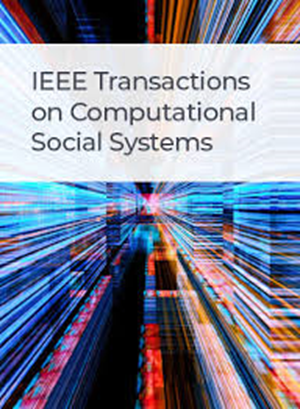MEFaND: A Multimodel Framework for Early Fake News Detection
IF 4.5
2区 计算机科学
Q1 COMPUTER SCIENCE, CYBERNETICS
IEEE Transactions on Computational Social Systems
Pub Date : 2024-02-09
DOI:10.1109/TCSS.2024.3355300
引用次数: 0
Abstract
Alongside social media platforms’ rise in popularity, fake news circulation has increased, highlighting the need for more practical methods to detect this phenomenon. The constantly evolving format of fake news makes it difficult for approaches that rely on a single modality of news to generalize the different types of false news. Furthermore, earlier approaches require extensive propagation data to determine the veracity of news, which can be challenging to collect in the early stages of news dissemination. Thus, we propose a multimodal early fake news detection approach that leverages latent insights into both news content and propagation knowledge. We design a multimodule architecture using graph neural networks (GNNs) to represent edge-enhanced and node-enhanced propagation graphs and bidirectional encoder representations from transformers (BERTs) to generate contextualized representations of news content. Our approach tackles the challenge of early detection in a more realistic scenario, accessing early propagation data in a single social media post and short-length news content. Moreover, we conduct comprehensive studies on user characteristics using statistical techniques to identify attributes with strong discriminative capability for identifying false news. We also analyze temporal and structural properties of fake news propagation graphs to demonstrate distinguishable patterns of false and real news behavior. Our model outperforms several state-of-the-art methods, achieving an impressive F1-score of 99% and 96% on two public datasets. The individual contribution of various components in our model to the final performance is also measured, which can be insightful for future research on multimodal false news detection.MEFaND:用于早期假新闻检测的多模型框架
随着社交媒体平台的普及,虚假新闻的传播量也在不断增加,这就凸显出我们需要更实用的方法来检测这一现象。由于假新闻的形式不断变化,依赖于单一新闻模式的方法很难归纳出不同类型的假新闻。此外,早期的方法需要大量的传播数据来确定新闻的真实性,而在新闻传播的早期阶段收集这些数据具有挑战性。因此,我们提出了一种多模态早期假新闻检测方法,利用对新闻内容和传播知识的潜在洞察力。我们设计了一种多模块架构,利用图神经网络(GNN)来表示边缘增强和节点增强的传播图,并利用变压器的双向编码器表示法(BERT)来生成新闻内容的上下文表示法。我们的方法在更现实的场景中应对早期检测的挑战,在单个社交媒体帖子和短篇新闻内容中获取早期传播数据。此外,我们还利用统计技术对用户特征进行了全面研究,以确定在识别虚假新闻方面具有较强鉴别能力的属性。我们还分析了虚假新闻传播图的时间和结构属性,以展示虚假新闻和真实新闻行为的可区分模式。我们的模型优于几种最先进的方法,在两个公共数据集上分别取得了 99% 和 96% 的惊人 F1 分数。我们还测量了模型中各个组成部分对最终性能的贡献,这对未来多模态虚假新闻检测的研究很有启发。
本文章由计算机程序翻译,如有差异,请以英文原文为准。
求助全文
约1分钟内获得全文
求助全文
来源期刊

IEEE Transactions on Computational Social Systems
Social Sciences-Social Sciences (miscellaneous)
CiteScore
10.00
自引率
20.00%
发文量
316
期刊介绍:
IEEE Transactions on Computational Social Systems focuses on such topics as modeling, simulation, analysis and understanding of social systems from the quantitative and/or computational perspective. "Systems" include man-man, man-machine and machine-machine organizations and adversarial situations as well as social media structures and their dynamics. More specifically, the proposed transactions publishes articles on modeling the dynamics of social systems, methodologies for incorporating and representing socio-cultural and behavioral aspects in computational modeling, analysis of social system behavior and structure, and paradigms for social systems modeling and simulation. The journal also features articles on social network dynamics, social intelligence and cognition, social systems design and architectures, socio-cultural modeling and representation, and computational behavior modeling, and their applications.
文献相关原料
| 公司名称 | 产品信息 | 采购帮参考价格 |
|---|
 求助内容:
求助内容: 应助结果提醒方式:
应助结果提醒方式:


